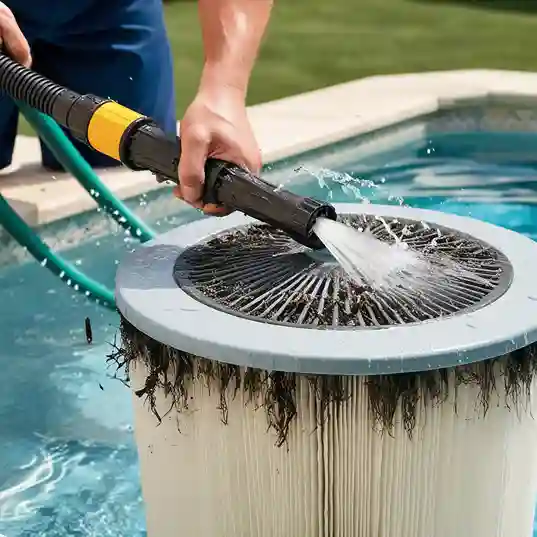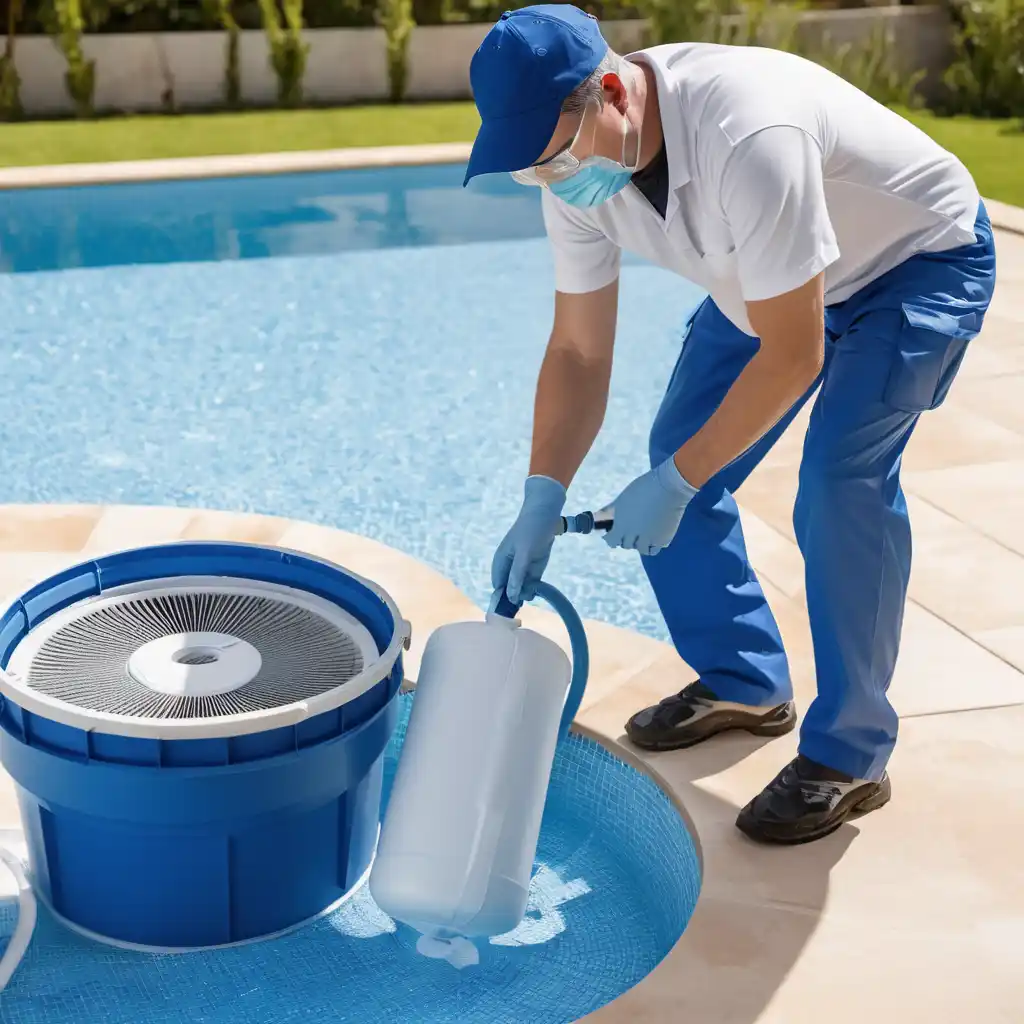Pool filter maintenance is essential to ensure your pool water stays clean, healthy, and crystal clear. First, the filter traps dirt, debris, and contaminants, preventing them from circulating back into the pool. Furthermore, proper maintenance not only extends the lifespan of your filtration system but also protects your pool equipment from damage. On the other hand, neglecting filter care can result in clogs, reduced water quality, and expensive repairs. Finally, this guide covers types of pool filters, how to clean them, required tools, and best practices for long-term maintenance.
Understanding Pool Filters
Before diving into cleaning procedures, it’s crucial to understand your filter type. In fact, there are three primary types: cartridge filters, sand filters, and DE filters. Moreover, recognizing the differences among them will help you choose the appropriate maintenance methods. Consequently, this knowledge will lead to more effective cleaning and better pool performance.
Cartridge Pool Filter
- Cartridge filters use a pleated fabric to capture debris. The pleats trap particles, making them popular for residential pools due to their efficiency and ease of maintenance.
Sand Pool Filter
- Sand filters use graded sand to trap particles. Water passes through the sand, where debris is captured. These filters are durable and suitable for larger pools, but regular backwashing is required to remove trapped dirt.
DE Pool Filter (Diatomaceous Earth)
- DE filters use diatomaceous earth, a fine powder, to trap even the smallest particles. In fact, this type of filter is the most effective. However, it requires frequent cleaning, and new DE powder must be added after each backwashing. Consequently, while it offers excellent filtration, it also demands consistent upkeep.
Each filter type has a unique cleaning process, which will be detailed in the following sections.

Types of Pool Filters and Their Cleaning Methods
Cartridge Pool Filter Cleaning
A cartridge pool filter captures dirt and impurities in its pleats, which can become clogged over time. Regular cleaning ensures optimal filter performance.
Cleaning Steps:
- Turn off the pool pump and remove the cartridge.
- Rinse the cartridge using a garden hose at a 45-degree angle to clean the pleats.
- Soak the cartridge in a filter cleaning solution for 6–12 hours to dissolve oils and dirt.
- Rinse again and air dry the cartridge before reinstalling.
Sand Pool Filter Cleaning
The sand filter captures debris in the sand, which is cleaned through a process called backwashing.
Cleaning Steps:
- Turn off the pump and set the valve to “backwash.”
- Run the pump for 2–3 minutes until the water runs clear.
- Set the valve to “rinse” for 30–60 seconds to resettle the sand.
- Return the valve to “filter” mode and restart the pump.
DE Pool Filter Cleaning
The DE filter requires regular cleaning and fresh DE powder after each backwash.
Cleaning Steps:
- Turn off the pump and remove the DE grids.
- Rinse the grids with a hose to remove the old DE powder.
- Soak the grids in a cleaning solution to dissolve oils and dirt.
- Reassemble the grids and add new DE powder to the skimmer after backwashing.
Tools You’ll Need for Pool Filter Cleaning
To clean your filter, you’ll need the following tools:
Garden Hose
Essential for rinsing debris from cartridge and DE filters.
Filter Cleaning Solution
A specialized solution designed to soak and deep-clean the filter material.
Soaking Bucket
Useful for submerging cartridge and DE filters in cleaning solutions.
Backwash Hose
Necessary for directing water away during backwashing with sand and DE filters.
Having the right tools ensures your filter cleaning process is efficient and effective.
Step-by-Step Guide to Cleaning Your Pool Filter

Cartridge Pool Filter Cleaning Process
- Turn off the pump and remove the filter cartridge.
- Use a garden hose to rinse the pleats thoroughly.
- Soak the cartridge in a filter cleaning solution.
- Rinse again and let it air dry before replacing it in the filter housing.
Sand Pool Filter Cleaning Process
- Turn off the pump and set the valve to the backwash position.
- Backwash the filter for 2–3 minutes.
- Set the valve to rinse and run for 30–60 seconds.
- Switch the valve back to filter mode and restart the pump.
DE Pool Filter Cleaning Process
- Turn off the pump and remove the grids.
- Rinse the grids to remove residual DE powder.
- Soak the grids in a cleaning solution.
- Reassemble and add fresh DE powder after backwashing.
Signs Your Pool Filter Needs Cleaning
Several signs indicate when your filter requires cleaning:
Decreased Water Flow
- If you notice reduced water flow, your pool filter might be clogged.
Increased Filter Pressure
- A high reading on the filter’s pressure gauge indicates debris buildup.
Cloudy Water
- If the water becomes cloudy, the filter may not be cleaning it efficiently.
Longer Cleaning Cycles
- A pool filter that takes longer than usual to clean your filter needs deep cleaning.
H2: Best Practices for Pool Filter Maintenance
To maintain your filter efficiently, follow these best practices:
Clean Regularly
Cartridge filters, for instance, should be cleaned every 2–4 weeks. Similarly, sand filters need monthly backwashing; additionally, sand replacement is necessary every 3–5 years. In contrast, DE filters require cleaning every 1–3 months, and fresh DE should be added after backwashing.
Use Proper Cleaning Solutions
- Avoid harsh chemicals that could damage the filter material; stick to specialized cleaning solutions.
Seasonal Adjustments
- During summer, when the filter is used more frequently, clean your pool filter more often.
By following these guidelines, you’ll extend the life of your filter and keep the water sparkling.
Common Pool Filter Problems and Solutions

Sometimes, you might face problems with your filter that affect performance. Here are some common issues:
Clogged Filters
- Regular cleaning prevents debris buildup and ensures smooth water circulation.
Leaks
- If water leaks around the filter housing, check for a broken seal or damaged o-ring. Replace as needed.
Poor Water Circulation
- Poor circulation is usually due to a dirty or damaged filter. Clean it regularly and inspect for damage.
Conclusion
Maintaining a clean and well-functioning pool filter is essential for a healthy and enjoyable swimming experience. Whether you own a cartridge, sand, or DE pool filter, following the correct cleaning and maintenance schedule will not only extend its life but also ensure clear, inviting water.
Additionally, by identifying the type of filter you have and using the appropriate cleaning methods, you’ll be able to avoid costly repairs. Moreover, keeping an eye on warning signs will help you enjoy a sparkling pool all year long. Ultimately, regular maintenance is key to preventing issues and, consequently, keeping your filter working efficiently.
FAQs
Q1: Why is pool filter maintenance important?
A1: Pool filter maintenance is crucial because it keeps water clean and safe for swimming. Additionally, it extends your filter’s lifespan, so you save money on repairs. Without proper care, clogs can occur, leading to poor water quality and equipment damage.
Q2: How often should I clean my pool filter?
A2: You should clean cartridge filters every 2–4 weeks; however, sand filters require monthly backwashing. DE filters, on the other hand, need cleaning every 1–3 months. Moreover, in summer, consider cleaning more frequently to maintain performance.
Q3: What tools do I need for pool filter cleaning?
A3: To clean your pool filter effectively, you’ll first need a garden hose, filter cleaning solution, and soaking bucket. Additionally, a backwash hose is handy for directing water away. Moreover, having these tools not only makes cleaning efficient but also straightforward. Ultimately, being well-prepared will enhance your cleaning process.
Q4: What are the signs that my pool filter needs cleaning?
A4: Signs of filter inefficiency include decreased water flow and increased pressure; additionally, cloudy water indicates that your filter is not functioning properly. Moreover, if cleaning cycles take longer than usual, it’s a clear sign that your filter needs attention. Therefore, staying vigilant for these indicators is essential to maintaining optimal pool performance.
Ready to transform your outdoor space? Check out our comprehensive guide on in-ground pool installation here.

